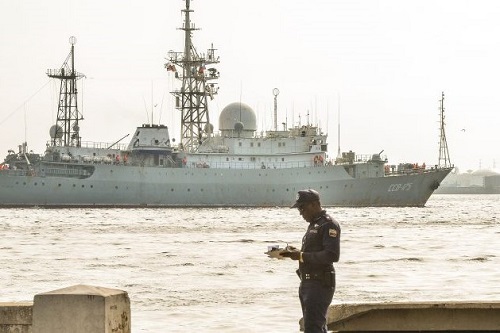AFP photo
By
Ricardo Swire
Four years ago Russia’s unresolved tensions with Ukraine forced it to return to Cold War tactics and test NATO defences. Russian security probes utilized “long-range aviation patrols from bases in the Arctic Ocean, across the Caribbean Basin and Gulf of Mexico. Later the Kremlin’s first “ground-based” nuclear-capable cruise missile was unveiled, violating a long-standing Moscow/Washington Arms Treaty. One year later increased Russian naval movements along North Sea and Southeast Asia routes were observed. Without firing a single shot Russian warships navigating the Atlantic Ocean pose a serious NATO threat. Underwater fibre-optic cables, vital to international trade and internet connectivity, can be severed.
The submerged facility accommodates ninety-seven percent of global communications and approximately US$10 trillion in daily commercial transactions. 2017 British reports chronicled forty “close military encounters between Russia and the West” in eight months. Russian pilots violated national airspaces, caused Western quick reaction forces’ “emergency scrambles,” near-miss mid-air war plane scenarios and maritime close encounters. On February 10, 2017 Russian fighter jets “buzzed” or agitated US Navy Ship (USS) Porter, while the vessel was on patrol in the Black Sea. The Russian military aircraft flew as close as two hundred yard to the US Navy ship’s superstructure.
Moscow’s Caribbean interest has evolved to a point where diplomatic profile and economic presence are strongest. Forging a long term military presence in Latin America and the Caribbean is part of Russia’s strategy to eventually erode US dominance, plus contest Western influence. The world’s largest country by area, with a US$1.72 trillion Gross Domestic Product (GDP), does not have China’s strategic enthusiasm but offers alternative foreign policy. “State-led” economic interest and re-engagement with Cuba broadened Moscow’s spectrum of Caribbean relationships.
On January 15, 2018 the Viktor Leonov, a Russian Navy intelligence collection ship, departed Port-of-Spain, Trinidad & Tobago after spending five days in transit resupplying. One Russian crew member posted Facebook pictures from the tropical Caribbean Twin Island Republic. US Department of Defence (DOD) and Pentagon data listed the Russian spy ship’s forward destination as unknown. CARICOM’s intelligence apparatus monitored Victor Leonov’s Caribbean Basin approach.
The Russian vessel is a “Vishnya-class” intelligence collection ship equipped to monitor ship-to-ship, ship-to-shore and radio frequencies. In the middle of December 2017, outfitted with surface-to-air missiles, it departed north-eastern Russia. Victor Leonov navigated the English Channel on Christmas Eve. In March 2018 the Russian ship sailed close to Cape Canaveral, Norfolk, New London in Connecticut and Kings Bay, Georgia, USA. Kings Bay accommodates the US Navy Submarine Group 10, inclusive of ten nuclear missile submarines and special operations underwater forces.
Norfolk houses the prominent US Navy East Coast base. Viktor Leonov also sailed past the Naval Submarine Base, New London, thirty miles south of Gordon Connecticut. Pentagon officials anticipated the Russian spy vessel’s voyage south would traverse the East Coast and back to the Caribbean. The US Navy destroyer Cole assigned to shadow the Viktor Leonov. CARICOM’s national intelligence data documented a previous six month deployment when Viktor Leonov steered courses to Cuba and Nicaragua.
Ricardo Swire
Ricardo Swire is the Principal Consultant at R-L-H Security Consultants & Business Support Services and writes on a number of important issues.



No Comments Yet!
You can be first to comment this post!